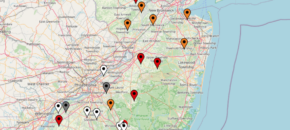Cucurbit downy mildew (CDM) has been reported on pumpkin in central New Jersey (8/18) and on yellow summer squash and zucchini in southern New Jersey. These are the first reports of CDM on pumpkin and summer squash in the state and region this growing season. All cucurbit growers should scout on a daily basis and […]
Continue reading...2025 USDA Sustainable Agriculture Farmer Grant Project Information

Farmers in the Northeast can apply for up to $30,000 in funding for sustainable agriculture projects starting in 2025. These projects can range from experiments to on-farm events and demonstrations or other educational activities. The Call for 2025 Northeast Sustainable Agriculture Research and Education (SARE) Farmer Grants is now available. Approximately $850,000 has been allocated […]
Continue reading...Tree Fruit IPM Report August 20, 2024
Peach: Tarnished Plant Bugs; and Other Catfacing Insects: BMSB and native catfacing insects remain very active. Some recent fruit feeding has been observed. Scale Insects: Second generation san jose scale and white peach scale crawlers began emergence in late July and will continue through August. Late season treatments include Actara (14 day PHI); Esteem (14 […]
Continue reading...Cucurbit Downy Mildew Update 8/18/24
Cucurbit Downy Mildew Update Cucurbit downy mildew (CDM) was discovered by IPM technician Chris Cloutier in Morris County, just south of Morristown on Friday. Suspect leaves from pumpkin plants were incubated and ultimately produced spores on Sunday. All NJ growers of pumpkins and winter squash should treat fields accordingly. Look for chlorotic areas bordered by […]
Continue reading...Vegetable IPM Update 8/14/24

Sweet Corn Fall armyworm (FAW) infestations remain present, although they have become lighter and more sporadic in most scouted locations in central and northern NJ counties. Re-infestations following treatment can and have occurred. Because FAW moths are highly mobile, it is important to monitor fields at least weekly for signs of infestation. Whorl stage […]
Continue reading...Call for Comments for Potential Mancozeb Registration Changes
The United States Environmental Protection Agency (EPA) released their proposed interim registration review decision for mancozeb in July 2024. The proposed changes include a cancelation of all uses in grape (table, wine, juice, and raisin) along with other label changes to address spray drift and soil erosion/surface water runoff risks. Mancozeb is a multisite mode […]
Continue reading...